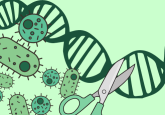To pee or not to pee

Using CRISPR technology, researchers have identified a molecular antidote for jellyfish venom, creating a new treatment for stings that doesn’t involve urine.
Despite the widely-believed myth, peeing on a jellyfish sting does not help with the pain. In actual fact, it can have the opposite effect, causing the creature’s nematocysts to release more venom which increases the stinging sensation. Researchers from the University of Sydney (NSW, Australia) have now developed an antidote to treat a sting from one of the most venomous of its species – the Australian box jellyfish. Discovered using CRISPR genome editing techniques, the antidote can block symptoms within 15 minutes of coming into contact with the jellyfish venom, a much greater efficacy than urine.
Found on the coast of northern Australia, the Australian box jellyfish has about 60 tentacles – each up to 3 meters long. A single sting can cause excruciating pain, necrosis of the skin and, at a large enough dose, can be fatal; each animal has enough venom to kill over 60 humans.
“It’s the first molecular dissection of how this type of venom works, and possibly how any venom works.”
When studying how the venom worked, the research team discovered a medicine able to overcome the deadly effects and halt the symptoms. Already shown to be effective in vitro on human cells and in live mice, the researchers are now working towards developing a topical application for in vivo human use.
“We were looking at how the venom works, to try to better understand how it causes pain. Using new CRISPR genome editing techniques we could quickly identify how this venom kills human cells. Luckily, there was already a drug that could act on the pathway the venom uses to kill cells, and when we tried this drug as a venom antidote on mice, we found it could block the tissue scarring and pain related to jellyfish stings,” explained senior author Greg Neely. “It is super exciting.”
Using the CRISPR technique to knockout different genes, the team identified which cells could survive when given a high dose of the box jellyfish venom. From whole-genome screening they were able to identify the factors in the cells that are required for the venom to take action; in removing these factors they were able to block the pathway of venomous activity.
-
How wasp venom upgrades its sting
-
Shot in the dark: uncovering the secrets in the genome of ‘The Prince of Darkness’
-
Low fat CRISPR
“The jellyfish venom pathway we identified in this study requires cholesterol, and since there are lots of drugs available that target cholesterol, we could try to block this pathway to see how this impacted venom activity. We took one of those drugs, which we know is safe for human use, and we used it against the venom, and it worked,” commented Raymond (Man-Tat) Lau, lead author on the paper. “It’s a molecular antidote.”
“It’s the first molecular dissection of how this type of venom works, and possibly how any venom works,” Lau added. “I haven’t seen a study like this for any other venom.”
“Our antidote is a medicine that blocks the venom. You need to get it onto the site within 15 minutes. In our study, we injected it. But the plan would be a spray or a topical cream. The argument against a cream is when you are stung it leaves lots of little stingers in you so if you rub the cream on it might be squeezing more venom into you. But if you spray, it could neutralize what’s left outside of your body,” Neely continued.
He added: “We know the drug will stop the necrosis, skin scarring and the pain completely when applied to the skin; we don’t know yet if it will stop a heart attack. That will need more research and we are applying for funding to continue this work.”





